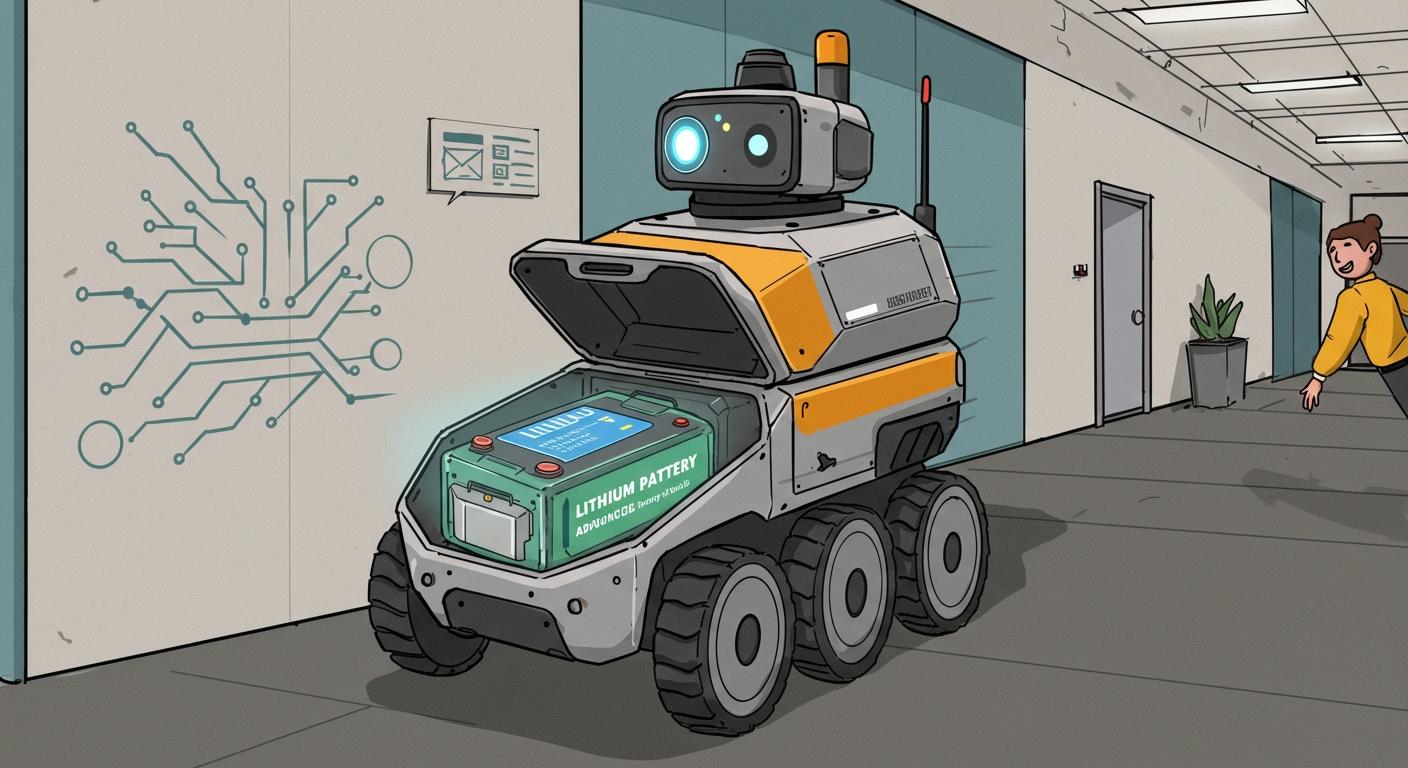
When you choose lithium-ion batteries for autonomous mobile robots, you gain a clear advantage over lead-acid and nickel-metal hydride types. These batteries offer higher energy capacity, faster charging, and lower maintenance needs. You see less downtime, improved safety, and better reliability in electric security and automation deployments. In mobile robotics, lithium energy storage boosts operational efficiency, helping robots patrol longer and work smarter.
Initial cost runs higher, but lithium-ion batteries last longer and require less upkeep.
Faster charging and longer cycle life increase uptime and productivity.
Reduced infrastructure needs and maintenance costs lower total cost of ownership.
Key Takeaways
Lithium-ion batteries provide higher energy density, allowing robots to patrol longer without frequent recharges.
Fast charging capabilities reduce downtime, enabling robots to return to service quickly and maintain continuous operations.
Lower maintenance needs and longer cycle life lead to significant cost savings, reducing total ownership costs by up to 30%.
Lightweight design enhances mobility, allowing robots to navigate complex environments more efficiently.
Safety features like thermal stability and smart monitoring systems ensure reliable performance in demanding conditions.
Part 1: Energy Density

1.1 Longer Patrol Time
Energy density measures how much power a battery can store for its weight. In mobile robotics and automation, you need batteries that deliver high energy density to keep your autonomous robots working longer between charges. Lithium-ion batteries, especially LiFePO4 types, offer about 100 Wh/kg, which is much higher than older battery technologies. In 2023, researchers even developed lithium batteries with energy densities reaching 711.30 Wh/kg, showing the potential for even longer patrol times in the future.
When your security or electric patrol robots use batteries with higher energy density, you get:
Extended operational endurance for each patrol cycle
Fewer interruptions for recharging
Greater coverage in large facilities or outdoor environments
This advantage is critical for B2B clients who rely on continuous monitoring and efficient automation in sectors like security, infrastructure, and industrial operations.
1.2 Efficient Power Use
Efficient power use means your robots can do more work with less energy. Lithium-ion batteries help you achieve this by delivering steady voltage and reliable performance throughout each cycle. This efficiency supports longer patrols and reduces the need for frequent battery swaps or downtime.
Here is a comparison of common lithium battery chemistries used in robotics, security systems, and other sectors:
Chemistry | Energy Density (Wh/kg) | Platform Voltage (V) | Cycle Life (cycles) | Application Scenarios |
|---|---|---|---|---|
LiFePO4 | ~100 | 3.2 | 2000–5000 | Robotics, security, infrastructure |
NMC | 150–220 | 3.6 | 1000–2000 | Medical, industrial, consumer |
LCO | 150–200 | 3.7 | 500–1000 | Consumer electronics |
LMO | 100–150 | 3.7 | 300–700 | Power tools, industrial |
LTO | 70–80 | 2.4 | 7000–20000 | Infrastructure, grid storage |
Solid-state | 250–500 | 3.7–4.2 | 1000–5000 | Next-gen robotics, medical |
Lithium metal | 400–500 | 3.7–4.2 | 500–1000 | Advanced robotics, aerospace |
You can see that lithium-ion batteries, especially LiFePO4 and NMC, strike a balance between energy density, safety, and cycle life. This makes them ideal for electric autonomous robots in security and automation roles.
Part 2: Lightweight Design

2.1 Enhanced Mobility
You want your autonomous patrol robots to move efficiently through complex environments. The lightweight design of lithium-ion batteries plays a key role in this. When you use batteries with less weight, your robots operate silently and efficiently for up to eight hours. This extended runtime means your robots can maintain a continuous presence on patrol routes, which is essential for security and automation tasks. You reduce the need for frequent charging stops, so your robots spend more time working and less time waiting.
Tip: Lighter batteries help your electric robots navigate tight spaces and uneven terrain with ease. You improve mobility and responsiveness, which is critical for mobile robotics in industrial and infrastructure settings.
When you compare lithium-ion batteries to other types, you see clear advantages:
Lithium-polymer batteries are even lighter than standard lithium-ion batteries because they do not need a rigid metal casing.
The lightweight nature of lithium-polymer batteries makes them ideal for applications where every gram counts, such as drones and some autonomous patrol robots.
2.2 Payload Optimization
Reducing battery weight gives you more flexibility in how you design your robots. Smaller batteries, like those enabled by advanced technologies from Large Power, lower the overall weight of your autonomous patrol robots. This reduction allows you to increase payload capacity, so your robots can carry more equipment or supplies without sacrificing performance.
You benefit from greater efficiency in electric and mobile robotics platforms. Less energy is needed to lift and maneuver the robot, which means you can add sensors, cameras, or other tools for enhanced security and automation. In B2B applications, this translates to improved operational capabilities and better return on investment.
Battery Type | Weight Impact | Typical Application |
|---|---|---|
Lithium-ion | Moderate | Security, industrial robots |
Lithium-polymer | Low | Drones, lightweight robots |
Lead-acid | High | Stationary backup systems |
You optimize both mobility and payload when you choose lithium battery packs for your autonomous patrol robots. This advantage supports longer patrols, more advanced features, and greater adaptability in demanding environments.
Part 3: Fast Charging
3.1 Reduced Downtime
You want your autonomous patrol robots to spend more time working and less time waiting. Fast charging technology in lithium-ion batteries helps you achieve this goal. When you use batteries that recharge quickly, your robots return to service faster after each patrol. This advantage supports electric security and automation operations, where every minute counts.
Quick charging means you can schedule shorter breaks for your robots. You keep your patrols active and your facility secure.
Let’s compare charging speeds across common lithium battery chemistries used in robotics, medical, security systems, infrastructure, consumer electronics, and industrial sectors:
Chemistry | Typical Fast Charging Time (to 80%) | Platform Voltage (V) | Application Scenario |
|---|---|---|---|
LiFePO4 | 1–2 hours | 3.2 | Robotics, security systems |
NMC | 1 hour | 3.6 | Medical, industrial |
LCO | 1–2 hours | 3.7 | Consumer electronics |
LMO | 1–2 hours | 3.7 | Industrial |
LTO | 10–20 minutes | 2.4 | Infrastructure, grid storage |
Solid-state | 1 hour | 3.7–4.2 | Next-gen robotics, medical |
Lithium metal | 1 hour | 3.7–4.2 | Advanced robotics |
You see that lithium-ion batteries, especially NMC and LTO, offer rapid charging. This feature reduces downtime and keeps your robots ready for action.
3.2 Continuous Operation
Fast charging supports continuous operation in electric automation environments. You maintain a steady workflow because your robots spend less time docked and more time patrolling. High energy density and lightweight design also help your robots operate longer between charges.
Lithium-based batteries deliver longer operational periods.
Lightweight packs improve mobility and efficiency.
Fast charging keeps your robots in service with minimal interruption.
You improve security coverage and automation efficiency when you choose lithium-ion batteries for your autonomous robots. Your business benefits from reliable patrols and reduced maintenance schedules.
Part 4: Cycle Life & Cost
4.1 Frequent Use
You rely on your autonomous patrol robots for continuous security and electric operations. The cycle life of lithium-ion batteries gives you a clear advantage. These batteries support frequent use without rapid degradation. You can see the difference in the table below:
Battery Type | Average Cycle Life |
|---|---|
Lead-Acid | 200 – 1,500 cycles |
Lithium-Ion | 2,000 – 3,000 cycles |
Lithium-ion batteries last much longer than lead-acid batteries. You get more patrol cycles before replacement, which means lower costs over time. The deeper depth of discharge allows you to use more of the battery’s capacity each cycle. This feature increases cost-effectiveness for your business. You reduce the need for frequent battery swaps, which helps you maintain uptime and reliability. When you choose lithium battery packs, you can lower your total cost of ownership by up to 30%. For more on sustainability, see our approach to sustainability.
4.2 Lower Maintenance
You want batteries that require minimal attention. Lithium-ion batteries offer low routine maintenance, which reduces operational overhead. Here are some key benefits:
High energy density supports longer operational periods.
Fast charge acceptance enables quick recharges during patrols.
Deep usable depth-of-discharge maximizes efficiency.
Low routine maintenance means less labor and fewer interruptions.
Lower total cost of ownership compared to lead-acid batteries.
You spend less time and money on battery upkeep. This reliability improves safety and ensures your robots stay on task. You also support responsible sourcing by choosing battery packs that meet conflict minerals standards. You gain more capacity for your security and automation needs, while keeping costs predictable and manageable.
Part 5: Safety & Reliability
5.1 LiFePO4 Stability
You need batteries that deliver both stability and efficiency in demanding environments. LiFePO4 (Lithium Iron Phosphate) chemistry stands out for its thermal and chemical stability. This makes it a top choice for autonomous patrol robots in security, medical, and industrial sectors. LiFePO4 batteries resist overheating and thermal runaway, even under heavy use. You benefit from a lower risk of fire or explosion compared to other lithium chemistries.
Note: LiFePO4 batteries maintain stable performance across a wide temperature range, supporting reliable patrols in both indoor and outdoor settings.
A smart Battery Management System (BMS) further enhances safety. The BMS monitors each cell, manages charging, and protects against unsafe conditions. Here are key safety features you gain with LiFePO4 battery packs:
Safety Feature | Description |
|---|---|
Safe Shutdown | The BMS can safely shut down the battery pack to prevent fire or explosion. |
Temperature Monitoring | The BMS tracks temperature data from each cell for added protection. |
UL Certification | BMS systems meet strict UL safety standards. |
Fail-Safe Redundancies | Hardware and software redundancies boost overall safety. |
5.2 Cylindrical Cell Safety
You want batteries that offer robust protection against electrical and thermal risks. Cylindrical cells, common in LiFePO4 and NMC battery packs, provide strong mechanical stability. These cells use physical spacing and current interrupt devices (CID) to prevent thermal events. You reduce the risk of short circuits and overheating.
Safety Feature | Description |
|---|---|
Overcharge Protection | Prevents charging beyond safe limits. |
Short-Circuit Prevention | Stops current flow if a short circuit occurs. |
Thermal Management System | Regulates temperature to avoid overheating. |
Tip: Cylindrical cells are widely used in robotics, security systems, and industrial automation due to their proven safety record.
5.3 Reliable Batteries
You need batteries that perform consistently in every patrol cycle. Advanced lithium-ion packs use smart BMS technology to monitor voltage, temperature, and charge status. This system communicates real-time data, so you always know your battery’s condition.
Industry certifications validate the safety and reliability of these batteries:
FCC certification ensures safe operation and electromagnetic compatibility.
UN 38.3, IEC 62133, UL 1642 / UL 2054, and CE Marking confirm compliance with global safety standards.
Many believe all lithium-ion batteries are the same, but advanced packs include features like CIDs and smart monitoring. These improvements deliver high energy density without sacrificing safety. You also support sustainability, as lithium-ion batteries remain recyclable and reusable in other applications.
Reliable lithium battery packs keep your autonomous patrol robots on duty, reducing risks and maximizing uptime in every deployment.
You gain a clear advantage when you choose lithium-ion batteries for your autonomous patrol robots. These batteries deliver:
High energy density for longer electric patrols
Fast charging that keeps security operations running
Long cycle life and low self-discharge for reliable uptime
Consistent performance in harsh environments
Custom battery packs help you extend operational range, free up space, and support future sensor needs.
Contribution to Sustainability Goals | Description |
|---|---|
Energy Efficiency | Lithium-ion batteries enable energy-efficient operations in robotics, reducing overall energy consumption. |
Carbon Emissions Reduction | Their use leads to lower carbon emissions, aligning with environmental regulations. |
Renewable Energy Integration | They support the integration of renewable energy sources, promoting greener practices. |
Recyclability | The components of lithium-ion batteries can be reused or repurposed, contributing to sustainability at the end of their life cycle. |
Evaluate your current battery solutions and consider upgrading to lithium-ion for better uptime, safety, and cost savings.
FAQ
What makes LiFePO4 batteries safer for autonomous patrol robots?
LiFePO4 batteries resist overheating and thermal runaway. You gain stable performance in harsh environments. The built-in Battery Management System (BMS) monitors temperature and voltage, reducing fire risk. This chemistry suits security, medical, and industrial robots that require high safety standards.
How does fast charging impact robot deployment schedules?
Fast charging lets you return robots to service quickly. You reduce downtime and keep patrols active. Lithium-ion chemistries like NMC and LTO support rapid charging, which helps you maintain continuous operations in security and industrial settings.
Why should you choose lithium-ion over lead-acid batteries for B2B robots?
Lithium-ion batteries offer higher energy density, longer cycle life, and lower maintenance. You get more patrol cycles and fewer replacements. This reduces your total cost of ownership by up to 30%. These benefits matter most in robotics, security, and infrastructure sectors.
Can lithium battery packs handle frequent deep discharges?
Yes. Lithium-ion batteries, especially LiFePO4 and NMC, support deep discharges without rapid wear. You use more of the battery’s capacity each cycle. This feature increases efficiency and reliability for robots in demanding B2B applications.
What certifications should you look for in lithium battery packs?
You should check for certifications like UL 1642, UL 2054, IEC 62133, UN 38.3, and CE Marking. These standards confirm safety and reliability. Certified packs ensure compliance in robotics, security systems, and industrial automation.




